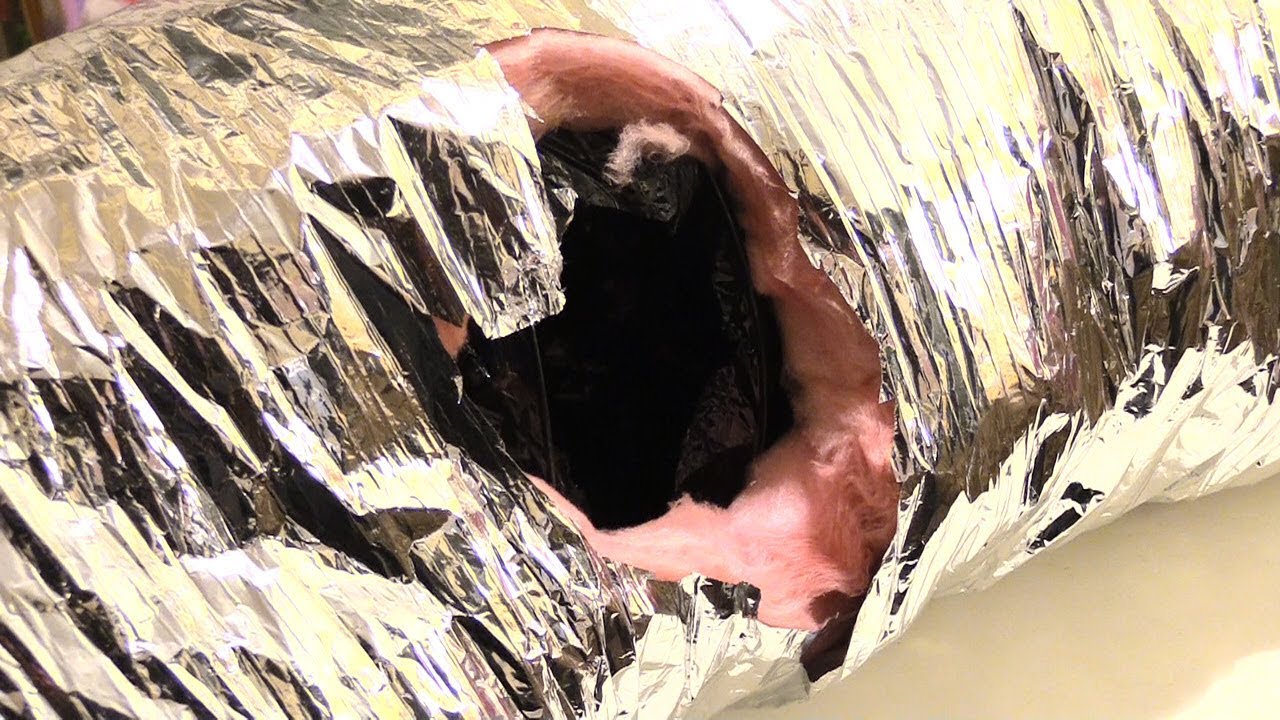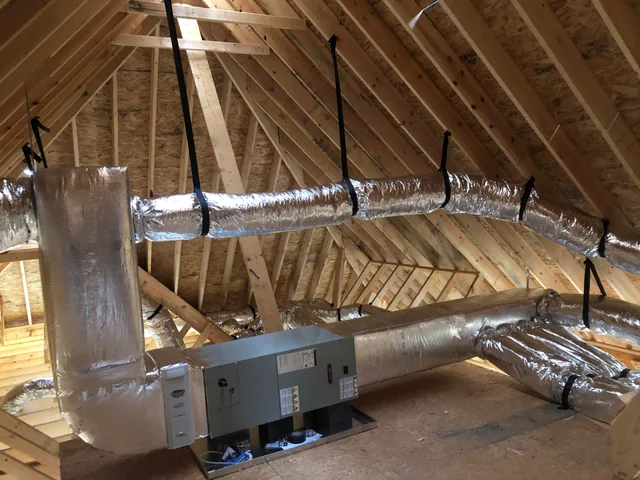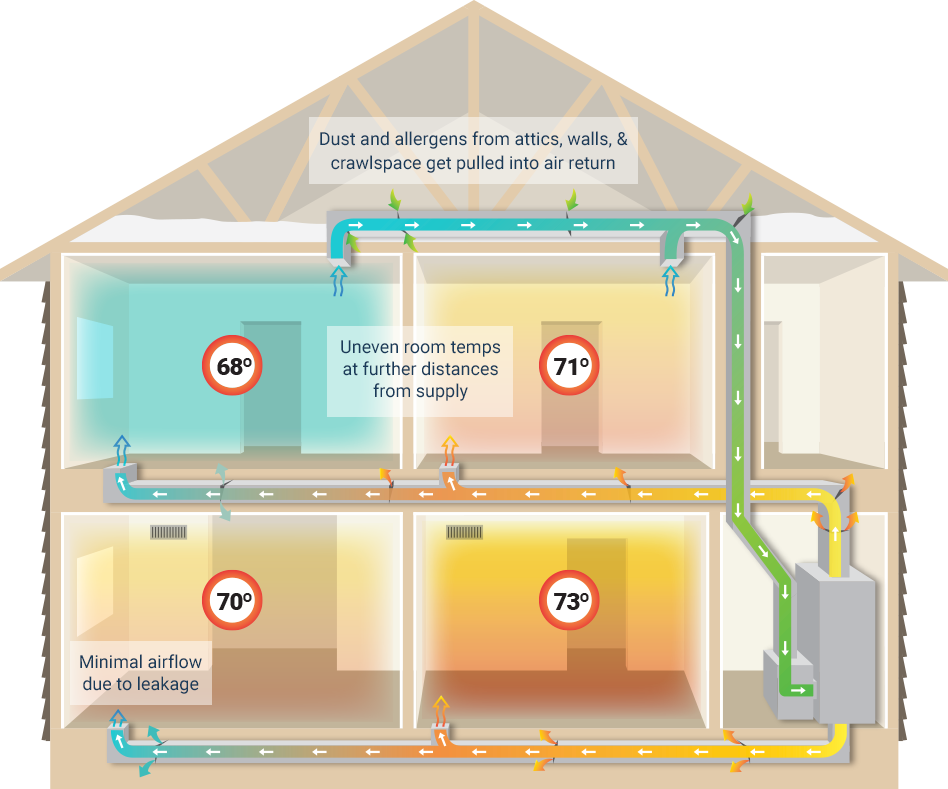Answered: What is Duct Leakage?

Did you know that up to 30% of the air your HVAC system produces can be lost through leaky ducts? This hidden problem impacts your comfort and wallet—it can also affect your health. Leaky ducts lead to uneven temperatures, higher energy bills, and reduced indoor air quality. Fortunately, addressing duct leakage is possible and can significantly improve your home’s energy efficiency and air quality.
Key Takeaways:
- Duct leakage can waste up to 30% of conditioned air, increasing energy bills.
- Common causes include aging materials, poor installation, and damage.
- Types of leaks include supply, equipment, and return leakage.
- Leaky ducts cause uneven temperatures, higher energy bills, and poor air quality.
- Solutions like Aeroseal technology and infrared detection can effectively seal leaks and improve HVAC performance.

Definition of Duct Leakage
Duct leakage refers to the loss of conditioned air—air that has been heated or cooled to maintain a comfortable indoor temperature—through gaps, cracks, or poorly sealed connections in your home’s ductwork. This loss reduces the efficiency of your heating and cooling system, forcing it to work harder to maintain the desired temperature.
Differentiating Between “Ductwork” and “Duct Work”
While “ductwork” refers to the network of ducts that distribute air throughout your home, “duct work” is a general term for tasks related to repairing or maintaining those ducts. Understanding this distinction can help you when discussing HVAC services with professionals.
Causes of Duct Leakage
- Aging Materials: Over time, seals and joints in the duct system can wear down or break, causing leaks.
- Poor Installation: Ducts that aren’t installed correctly often have weak joints or gaps.
- Vibration: HVAC systems naturally produce vibrations that can loosen duct connections over time.
- Damage: External factors, such as construction, pests, or regular wear and tear, can cause holes or tears in ducts.
Learn more: What is Duct Sealing?
Types of Duct Leakage
Duct leakage occurs in different forms, affecting your HVAC system’s performance differently.
Supply Leakage
Supply leakage happens when conditioned air escapes from the ducts before it reaches the intended rooms. This results in uneven temperatures and makes your HVAC system work harder to compensate for the lost air.
Equipment Leakage
This type of leakage occurs around the HVAC unit, particularly where it connects to the ductwork. When leaks occur at these connection points, the system’s efficiency is compromised.
Return Leakage
Return leakage happens when air intended to be recirculated back into the HVAC system escapes through leaks in the return ducts. This means your system might pull in unfiltered, unconditioned air from attics or crawl spaces, leading to poor indoor air quality.
Learn More: Top 5 Air Duct Sealing Methods

Common HVAC Issues Caused by Duct Leakage
Leaky ducts can cause many problems that affect your home’s comfort and safety.
Learn More: 5 Benefits to Duct Sealing
Uneven Room Temperatures
Due to duct leakage, some rooms may feel warmer or cooler than others. When air is lost before it reaches the intended space, your HVAC system can’t maintain consistent temperatures throughout your home.
Increased Dust and Allergens
Leaky ducts can pull dust, dirt, and allergens from unconditioned areas like basements or attics into your living spaces. This impacts air quality and exacerbates respiratory issues such as asthma and allergies.
Higher Energy Bills
Leaky ducts force your HVAC system to work harder to maintain comfortable temperatures, increasing energy consumption and utility bills. Properly sealed ducts can help reduce energy waste and save you money.
Detection and Solutions for Duct Leakage
Infrared Technology for Detection
Modern HVAC professionals often use infrared technology to detect duct leaks. This method identifies temperature differences in your ducts, revealing areas where conditioned air is escaping. It’s a quick and non-invasive way to locate hidden leaks.
Importance of Proper Duct Performance
Duct performance is crucial to your HVAC system’s overall efficiency. Leaky ducts disrupt airflow, reducing system effectiveness. Ensuring your ducts are properly sealed and maintained will enhance performance and keep your system running smoothly.
Seeking Assistance from an Aeroseal Dealer
Aeroseal technology offers a highly effective solution for sealing duct leaks from the inside. Aeroseal uses a non-toxic aerosol that’s injected into the duct system. This aerosol finds and seals leaks in hard-to-reach places, making it an ideal choice for comprehensive duct sealing. Partnering with an Aeroseal dealer ensures that your ducts are properly sealed, helping to maximize HVAC efficiency and improve indoor air quality.
Learn More: Aeroseal Duct Sealing Costs VS DIY
Conclusion
Duct leakage can cause uneven temperatures, poor air quality, and higher energy bills. Addressing it with infrared detection and Aeroseal sealing solutions can improve your home’s comfort, energy efficiency, and air quality. Taking action now will optimize your HVAC system’s performance and reduce long-term costs.


